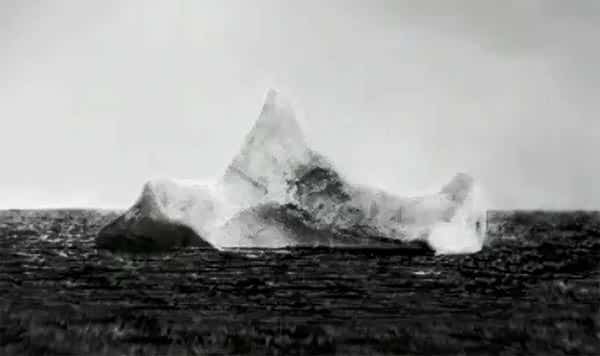
Above: The iceberg that sank Titanic? A photograph taken on the morning of the sinking by the chief steward of the liner Prinze Adelbert.
11:40 pm – the time at which Titanic hit an iceberg, on the evening of 14 April 1912, whilst traveling at speed through ice-laden waters in the remote Atlantic Ocean.
22.5 knots – the speed That Titanic was traveling (less than one knot below her top speed of 23 knots) when she struck the iceberg.
30 seconds – the length of time following the first sighting of the iceberg (by lookout Frederick Fleet, who rang the bridge to alert them of an “Iceberg, right ahead!”) that the ship collided with it, the iceberg tearing a hole in the starboard (right hand) side.
220-245 feet – the long-held estimate of the length of the gash caused by the collision (some estimates even extending this to 300 feet).
30 feet – the revised estimate of the length of the impact hole, as calculated by scientists of the Woods Hole Oceanographic Institution (WHOI).
11-12 feet² – the probable combined size of the impact apertures.
1,400 litres – the amount of sea water that this size gap would have allowed into the ship every second. The same scientists have calculated that this rate of water ingress would match the time it took Titanic to sink beneath the waves (if the hole had been as large as traditionally claimed the ship would have sunk much sooner).
5 – the number of compartments in the hull that began to flood after the impact.
2.5 hours – the approximate time from the impact that Titanic began to tilt and sink beneath the water.
2 – the number of sections that the ship broke into, the hull fracturing just in front of the third funnel. There is still debate as to whether the split occurred whilst the ship was still at the surface of the water, breaking in two as she angled up out of the water (as reported by some eye-witnesses) or whether the split actually happened whilst the ship was descending underwater (some scientists believe this is the only explanation for the relatively compact debris field).
Did You Know?
Whilst the bow section of the wreckage lies on the bottom looking relatively intact and recognisable, the stern section is in much worse condition, being broken, twisted and disfigured.
2.4 miles – the distance that the Titanic had to sink to reach the ocean floor.
15-20° – the angle at which the bow section struck the ocean bottom.
35 mph – the estimated speed at which the bow section hit the sea bottom (56 km/h).
Its descent was very smooth, it had its aerodynamic nose facing into the direction of travel -Bill Saunders, Director of Titanic Research, RMS Titanic Inc., describing the descent of the bow section, ‘Drain The Titanic’, National Geographic, 2015
60 feet – the depth that the bow penetrated the ocean floor, equivalent to a six-storey building (18 metres), leaving just feet (12 metres) of the bow section sits above the sea bed.
Did You Know?
Scientists from the Titanic Mapping Project have deduced from tracks found on the sea bed that the stern section was still turning, in a counter-clockwise direction, when it hit the ocean floor.
50 mph – the speed at which the stern section is estimated to have travelled to sea bottom. The drag caused by pressurised water at depth would have torn sections off the stern “like confetti” (Saunders). This, along with the greater speed of impact with the sea floor, is the reason why the stern section is in such a poor state compared to the bow.
Above: CGI showing the most commonly held opinion on how the Titanic sank, breaking in two at the surface (note: this visualisation does not show the stern spiralling as it impacts the sea bed, which is how scientists now believe this section arrived).
More To Explore
If you have found these facts on how the Titanic sank of interest, why not read more about the iceberg, read fascinating facts about the shipwreck, or see the complete Titanic timeline.
